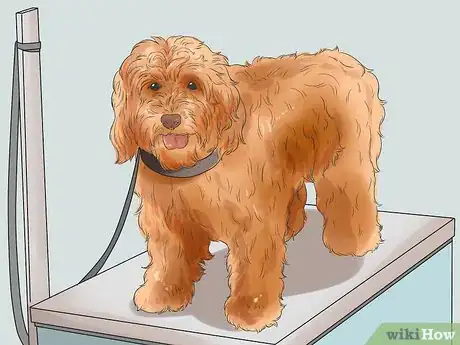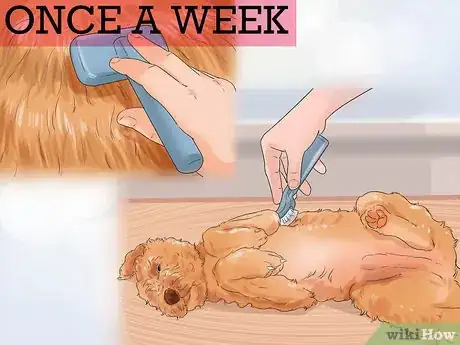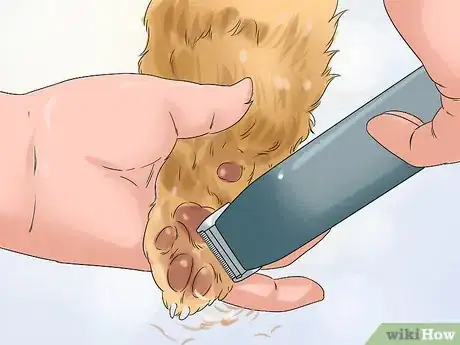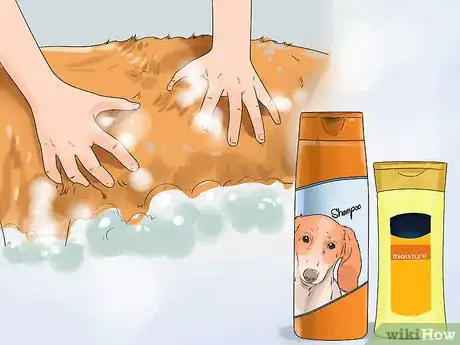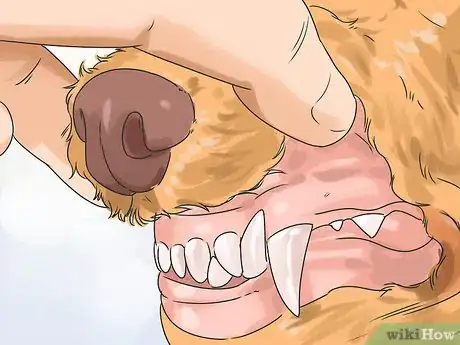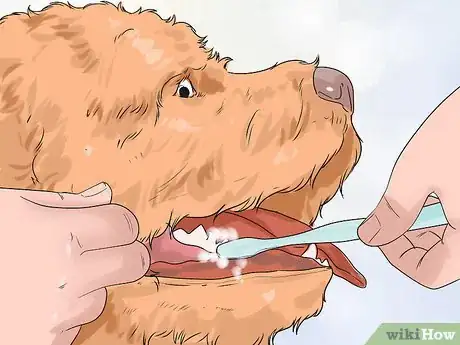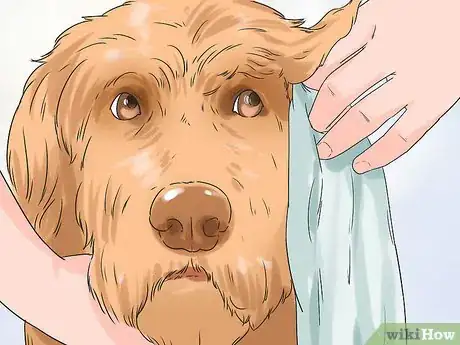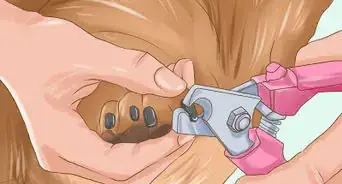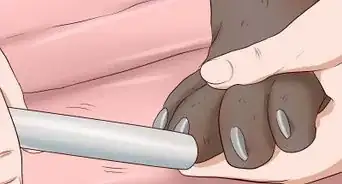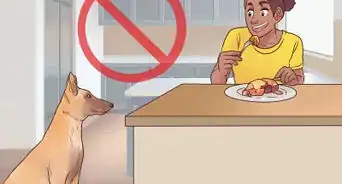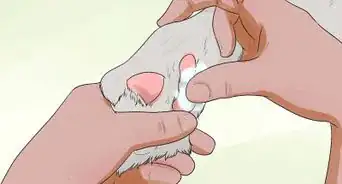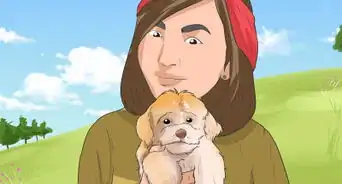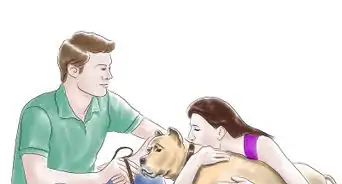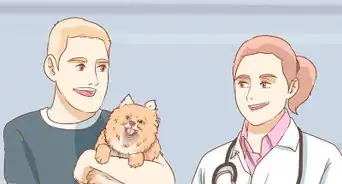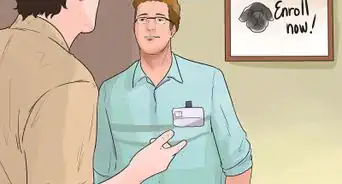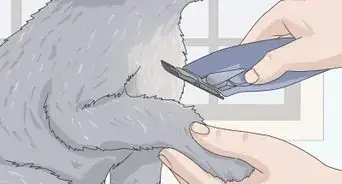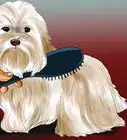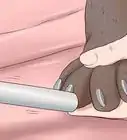This article was co-authored by Deanne Pawlisch, CVT, MA. Deanne Pawlisch is a Certified Veterinary Technician, who does corporate training for veterinary practices and has taught at the NAVTA-approved Veterinary Assistant Program at the Harper College in Illinois and in 2011 was elected to the board of the Veterinary Emergency and Critical Care Foundation. Deanne has been a Board Member of the Veterinary Emergency and Critical Care Foundation in San Antonio, Texas since 2011. She holds a BS in Anthropology from Loyola University and an MA in Anthropology from Northern Illinois University.
There are 14 references cited in this article, which can be found at the bottom of the page.
This article has been viewed 50,477 times.
Labradoodles have three different coat types: wool, hair, and fleece. The long fleece coat Labradoodle has soft and wavy fur that rarely sheds and is relatively easy to care for. You will need to keep the fleece coat trimmed, especially around their face and ears, and brushed regularly. Caring for their coat, as well as their teeth, ears, and nails, will help keep your long fleece coat Labradoodle looking their best.
Steps
Brushing the Coat
-
1Set your Labradoodle on the floor or a grooming table. In order to have access to each part of their coat, you’ll need to put your Labradoodle in a secure area either on the floor or on a grooming table. If they are unable to stay still during the grooming process, enlist the help of another person to hold them still while you’re working. Fleece coats are much easier to take care of than a wool coat, especially when the fleece coat is wavy rather than curled.[1]
- Remove their collar and any other accessories before you begin.
-
2Part the coat into sections. For brushing, you’ll want to work in sections starting at the head and moving down the body. Part the hair at the skin and work on one individual section at a time. It is better to work in small sections at first, especially if you are not accustomed to grooming at home. [2]Advertisement
-
3Brush one section at a time with a slicker brush. Slicker brushes have fine wire bristles that will help to remove mats and tangles from your Labradoodle’s thick fleece coat. [3] As you’re brushing, you want to make sure that you are brushing the hair all the way down to the skin. Many people only brush the surface of the coat and leave mats to form close to the skin.
- If you are unable to brush out any small or large mats, you will need to shave the hair right to the skin. A professional groomer may be able to get the mat out without cutting the hair, so it can be worth going in for a consultation.
-
4Focus on areas that are easily matted. While mats can occur anywhere on your dog’s coat, they tend to occur on the chest, neck, armpits, and behind and under the ears. Spend a little extra time brushing these sections with the slicker brush to ensure that no mats have formed.[4]
-
5Brush their coat once a week. For general maintenance, you’ll need to brush their coats once a week to prevent matting and tangles. Each time you brush their coats, look out for any skin irritation. If you see any redness, flakiness, scabbing or unusual skin texture you may need to consult your veterinarian.[5]
- By brushing frequently, your dog will become accustomed to the process and you’ll be able to identify any skin problems early on.
-
6Deal with mats, if present. Mats occur when the hair close to the skin becomes extremely knotted and tangled. The best way to deal with mats, if they aren't too large or too tightly knotted, is to try to untangle them using your fingers. After you've broken apart some of the larger knots, use a comb to try to untangle the smaller knots. If you're able to, try to hold the fur closest to the skin so there is less pulling, which can be painful for your dog. Large mats may need to be shaved.[6]
- Regular brushing is the best way to prevent mats from forming.
- Avoid using scissors, as you may accidentally injure your dog.
Trimming the Fleece Coat
-
1Cut ear hair. Use a small pair of clippers to trim the hairs at the entrance to your dog’s ears. Like other flap eared dogs, Labradoodles are more prone to ear infections. Their ears hang down and trap moisture and bacteria in their ear canals. By shaving the ear hair and keeping it trimmed short, you can help improve circulation.[7]
- You want the hair that falls on the outside of their ears to be symmetrical lengths, usually about 1”, or 2.5 centimeter (1 in). Trim exterior ear hair as desired.[8]
-
2Trim the hair on their paws. The hair between their paw pads should be clipped short with a clipper. This helps to prevent debris getting stuck between the paws. You will also want to trim the hair that falls around the paws, in the ankle area, so the hair doesn’t trip up your dog. You want the hair to be short enough that it doesn’t impede their steps.
- Most dogs are sensitive with someone handling their paws, so start handling your dog’s feet when they are young so they become used to it.
- Avoid using scissors. You are likely to cut your pet by accident, and paws tend to bleed a lot.
-
3Trim the fur around their face. The hair around your dog’s eyes should be trimmed short so the hair does not fall into their eyes and restrict vision. The hair that grows up from the bridge of their noses should be kept short as well. The hair on their muzzle should be about 1”, or 2.5 cm, in length and hang evenly.
-
4Shave the entire coat as needed. Many groomers recommend fully shaving the entire coat twice a year down to an inch or shorter. This includes the neck, body and legs of the dog. Many owners choose to do this in the warmer months to help keep their dogs cool. You do not have to shave the coat if you prefer a longer coat year round; it comes down to owner preference.[9]
- If you do not shave the entire coat, you should plan on trimming the fur monthly.
Bathing Your Labradoodle
-
1Bathe them every month. Labradoodles have very little odor so they don’t need to be bathed any more than once a month, unless they’ve rolled in something smelly or muddy. Too frequent bathing will strip the skin of its natural oils, leaving it prone to skin irritations, and damages the coat.
- Some owners find that they can bathe their Labradoodle every other month, as long as there is no noticeable odor.
-
2Put your Labradoodle in a tub with a non-slip mat. Fill the tub a few inches with warm, but not hot, water. Wet your dog using a plastic cup filled with water, a spray nozzle, or your hands. Try to wet the entire coat, but avoid getting water inside their ears.
-
3Use a gentle shampoo and massage it into the fur. Use a dog-specific shampoo, as these are formulated with a pH that is best for dogs.[10] Some shampoos with fragrances can irritate the skin, so avoid these unless you already know that they do not bother your dog’s skin. Put a small amount of shampoo into the palms of your hands and begin to work the shampoo into a lather on the body of the dog. Massage the shampoo into the dog’s coat, making sure you spend extra time around their paws and rear end since these become dirty easily. After fully washing the body, move on to the head and face.[11]
- Be extra careful with the shampoo around your dog’s eyes. While most puppy shampoos are tearless, you still want to avoid getting shampoo directly in your dog’s eyes.
-
4Rinse out the shampoo. Using a plastic cup filled with water, a spray nozzle, or your hands, rinse out the shampoo with more warm water. Start with the head and face, and then move on to the body. Make sure you rinse off all of the shampoo. Dried shampoo that hasn’t been rinsed out can be itchy and cause skin irritation later on.[12]
-
5Dry them off. After the bath, you can dry your Labradoodle off by patting their coat with a cotton towel. Try not to rub in circular motions if your dog has a longer coat, since this may tangle the fur. They do not need to be dried using a blow dryer, though this will give the coat a full and fluffy appearance if that’s what you prefer.
- As long as it’s warm out, or they’re inside, you can leave them somewhat damp and let the coat air dry.
Grooming Your Labradoodle
-
1Examine their teeth and mouth. By the age of 3, more than 80% of dogs show signs of gum disease.[13] Oral hygiene is important for your dog, and many teeth and gum problems can be prevented through basic dental care. You should get into a routine of checking your dog’s gums and teeth. Check their gums for any redness, bleeding, inflammation, and any signs they are receding.[14] Check their teeth for any browning, as well as any chips or breakage.
- Labradoodles with dental problems may avoid playing with chew toys or eating hard food. They may also drool more, paw at their mouth, or have very bad breath.[15]
- Take your dog to their veterinarian if you notice any signs of gum or tooth damage.
-
2Brush their teeth. Brushing your dog’s teeth regularly is the best way to prevent later dental problems, like tooth decay and periodontal diseases. Use toothpaste that is specially designed for dogs and a soft toothbrush. Put a small amount of toothpaste on a wet toothbrush and use one hand to hold their mouth open while you brush each tooth.[16]
- Ideally, you’ll brush their teeth every day. Your goal should be to brush them at least two to three times a week to help prevent periodontal diseases.[17]
-
3Trim their nails. For larger and medium sized Labradoodles, it’s easiest to use a pair of scissor nail clippers. These look more like scissors and can cut through thicker nails. Only trim a very small section of the nail at a time to avoid hitting the quick, which is a vein that runs through your dog’s nail and provides blood flow to the area.[18] Most dogs will need their nails trimmed about every two weeks.[19]
- It is harder to see the quick if your Labradoodle has black nails. Start by making a very small cut to the nail to make sure that you haven’t hit the quick. Have styptic powder and some cotton balls handy to stop the bleeding in the event that the quick has been nicked.
- You won’t need to trim your Labradoodle’s nails as frequently if you exercise them on pavement and concrete. The rough surface will naturally file your dog’s nails and keep them shorter.
-
4Wipe their ears. Like most flap eared dogs, Labradoodles are prone to ear infections. You should check their ears weekly for signs of infection, such as discharge, and wipe them down. If you suspect your dog may have an ear infection, take it to the vet right away. Otherwise, use a cotton ball soaked in a gentle, pH-balanced ear cleaner for dogs to wipe their inner ears and the opening of the ear canal.[20]
- Check their ears for any sign of infection, like redness, odor, or discharge.
References
- ↑ http://www.overthemoonlabradoodles.com/labradoodlecoattypegrooming.html
- ↑ http://dogtime.com/dog-breeds/labradoodle#/slide/1
- ↑ http://www.drsfostersmith.com/PIC/article.cfm?aid=248
- ↑ http://www.drsfostersmith.com/PIC/article.cfm?aid=248
- ↑ http://dogtime.com/dog-breeds/labradoodle#/slide/1
- ↑ http://www.petco.com/content/petco/PetcoStore/en_US/pet-services/resource-center/grooming/How-to-Comb-Out-Your-Dog-Matted-Fur.html
- ↑ http://www.kimberlenes-labradoodles.co.uk/faq
- ↑ http://www.overthemoonlabradoodles.com/labradoodlecoattypegrooming.html
- ↑ http://www.labradoodle-breeder.com/faq_labradoodles_groom.html
- ↑ http://www.labradoodle-breeder.com/faq_labradoodles_groom.html
- ↑ https://www.vetbabble.com/dogs/grooming-dogs/head-to-toe-dog-washing-guide/
- ↑ http://www.howtocleanstuff.net/how-to-wash-dogs/
- ↑ http://dogtime.com/dog-health/dog-dental-care/297-dental-care
- ↑ http://www.peteducation.com/article.cfm?c=2+2089&aid=379
- ↑ http://www.peteducation.com/article.cfm?c=2+2089&aid=379
- ↑ http://www.peteducation.com/article.cfm?c=2+2089&aid=384
- ↑ http://dogtime.com/dog-breeds/labradoodle#/slide/1
- ↑ https://www.vetbabble.com/dogs/grooming-dogs/trimming-dogs-nails/
- ↑ https://dogs.thefuntimesguide.com/how_to_trim_dog_nails/
- ↑ http://dogtime.com/dog-breeds/labradoodle#/slide/1
- ↑ http://www.aspca.org/pet-care/dog-care/dog-grooming-tips
About This Article
To groom a long fleece coated Labradoodle, brush its coat with a fine wire brush once a week to remove mats and tangles. Pay special attention to its chest, neck, armpits, and behind, since these are areas where mats commonly form. Then, trim the hair on its ears and paws with clippers to prevent infection or a build-up of debris. Additionally, brush your labradoodle’s teeth 2 to 3 times a week to prevent dental problems, and wipe their ears weekly to prevent ear infections. For tips from our Veterinary co-author on how to give your labradoodle a bath, read on!
